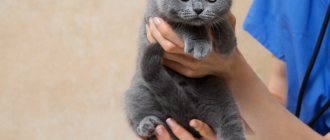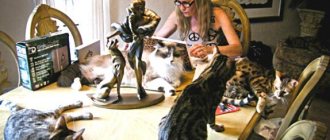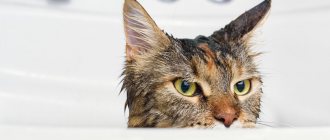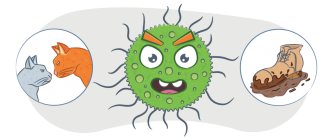What and how to feed stray cats
If you have a question “what to feed homeless cats,” it means that you want to help these unfortunate animals who are fighting for their lives every day, and you have a desire to make the world around you a little better. This is wonderful, because this desire is the cornerstone for everything else.
Although such a problem is deeper and more ambiguous than it seems at first glance, this is not a reason not to solve it. The Murkoshi team, whose goal is to save as many lives as possible from the streets of Moscow, has prepared for you some tips and answers to the most frequently asked questions.
1) Is it necessary to do this? Necessary!
2) How to feed stray cats?
3) What to feed stray cats?
4) What about food from your table?
5) What else is important to know in order to properly feed stray cats?
6) The key to the solution is sterilization of pets
7) What to do with those who are already on the street?
Should I do this? Necessary!
The first and most important: “Is it necessary to do this at all?” You can often hear from dissatisfied neighbors, just passers-by, Internet users on various forums or in groups on social networks that, they say, this is useless, since the more you feed, the more homeless people will become, or even harmful, leads to unsanitary conditions, which it causes inconvenience to others, that this is kindness at someone else’s expense, if you want, do this in your apartment, etc.
Indeed, if you simply feed homeless cats and kittens, then in itself, in isolation from other actions, this will not solve the problem of homelessness. On the other hand, such words are simply an excuse for one’s own inaction, indifference, and callousness. Those who say this are actually indifferent to animals, they lack empathy, and are accustomed to a consumerist attitude towards everything around them. They also remember other people (whose comfort and safety they appeal to) only when it is beneficial for them. If this line of behavior is unacceptable to you, then do not let such an attitude (alas, not uncommon these days) discourage you from wanting to help animals.
How to feed stray cats?
This is another important question. The best way is to unite with other people who hold similar views. For example, it’s worth getting to know a local volunteer organization (if there isn’t one yet, you can find people who live nearby and also care about animals via the Internet - this can become the basis for volunteering in your city) or at least cooperate with neighbors who also feed the homeless kittens This will provide a number of advantages.
Firstly, it will be easier to defend your right to help animals in front of utility workers and disgruntled neighbors. If they see that there are a lot of you, that you are serious, that you take a responsible approach to business, then they will leave you alone. By the way, in conversations with such neighbors, you need to gently but persistently convey to them the essence of your decision. Not everyone loves animals, but only a small part of people intentionally wish them harm. And therefore, reasonable arguments without aggression and accusations of callousness can help in such a situation.
Secondly, if you are not the only one doing the feeding, this will allow you to strictly adhere to the regime. It is highly advisable to feed stray cats regularly and at approximately the same time. Cats are time aware and will come hoping to meet you. This is especially important in winter, so that they do not have to wait long in the cold, the more cruel it would be to force them to get cold and go away hungry.
Thirdly, cooperation with other people will allow you to feed approximately the same thing, which is important. This brings us to the next important question.
What to feed stray cats?
You've probably heard that cat food comes in different classes: economy, premium, superpremium and holistic (sometimes there is also a medium - a cross between economy and premium). They differ in composition (economy - bone meal and waste from the meat industry, holistic - mainly meat with a small addition of by-products that are beneficial for the cat), the presence or absence of grains and flavorings (there are none in good food), the presence of useful minerals and vitamins, and of course , price.
Read more about different foods: https://www.murkosha.ru/nashi-stati/soderzhanie-i-ukhod/kakim-kormom-kormit-koshku
At Murkosh, we feed our charges with super-premium food and strongly recommend that all cat owners do the same (or use even higher-quality holistic food). At the same time, we understand that not everyone can afford to feed stray cats such food, especially when there are ten or more hungry mouths in the yard.
But economy-class food (Whiskas, Kitiket) is absolutely excluded. This is simply poison for cats, especially when it comes to dry food. Medium-class food (that is, those that cost a little more, but are also sold in regular supermarkets: “Perfect Kits”, “Purina”, etc.) are not much healthier, except that they cause less harm to the cat’s body. And then there is a significant increase in cost. So what should we do then?
Although uniting people will solve this problem, especially in large cities, where there are many specialized stores that often hold promotions and discounts (in small cities, in this case, you can order large packages directly from the manufacturer). If several people bear the costs, it will be easier for everyone individually. In addition, it will be easier to keep track of promotions and discounts, negotiate with suppliers, etc. In this case, it is quite possible to choose a relatively inexpensive, but more or less high-quality premium food, for example, Royal Canin, especially since it is often subject to various promotions, and feed it exactly. Sometimes you can give not only dry food, but also wet food or canned food as a treat.
What about food from your table?
In this case, natural food cannot be given. You definitely have to choose: give either specialized food or natural food. But the latter is not nearly as good for a cat as many people think, rather the opposite. Still, a cat’s body requires a different balance of substances than a human’s, and you will never achieve this balance by giving food from your table.
It is worth feeding natural food only if you are the only one involved in helping homeless people and you cannot afford even premium food in such quantities. But it’s still better to look for like-minded people – there are not so few caring people. However, if natural food is the only way out (economy-class food, as we said, should not even be considered), you must keep in mind that cats should not be given certain foods: raw meat and fish (they probably contain parasites); bones; anything that contains salt, spices and sugar; milk; liver, sausages, frankfurters; bread and pasta.
Read more about proper nutrition for cats: https://www.murkosha.ru/nashi-stati/soderzhanie-i-ukhod/pravilnoe-pitanie-koshek
What else is important to know to properly feed stray cats?
Use disposable plastic containers for feeding. Firstly, this way you can maintain cleanliness. This will allow you to quickly find a common language with dissatisfied neighbors, as it will deprive them of their main argument.
Secondly, you can feed each cat from a separate plate - this way there will be no fights and strong animals will not drive away weaker ones.
Now let's get back to what we briefly touched on at the very beginning. If you feed stray kittens, they won't starve (yet), but it won't rid them of the other dangers of the street, and it certainly won't solve the stray problem itself.
The key to the solution is sterilization of pets
If you have your own cat, is she spayed? Do you think that you “always place kittens in good hands”? Alas, most of them will sooner or later end up on the street. According to statistics, about 80% of street cats were previously indoor cats. And even if the kitten ends up with a really good person, he simply won’t take someone else, for example, that red-haired kitten that you have to feed to the displeased grumbling of your neighbors. And if your cat were sterilized, this good person could very well make him his pet.
Read in more detail why there are not enough “good hands” for everyone: https://www.murkosha.ru/nashi-stati/kastratsiya-i-sterilizatsiya/pochemu-neobkhodimo-sterilizovat-koshek
Thus, statistics from different countries of the world say that when the proportion of sterilized pets reaches 70-80%, the number of homeless people and those in shelters decreases sharply.
What to do with those who are already on the street?
Ideally, the state WWTP program should work: “catching - sterilization - vaccination - return.” But you can contribute too. If you have the opportunity to allocate certain funds for sterilization from time to time, we recommend that you take turns taking stray cats to the clinic for surgery. Again, cooperation with a local volunteer organization will be beneficial - they will help with advice and hands. In addition, many veterinary clinics give significant discounts to volunteers for sterilization of street animals.
In general, the solution to the problem of homeless animals rests on three “pillars”: mass sterilization, animal protection at the legislative level (fortunately, the first steps have been taken in Russia) and educating people around about the need for humane treatment of animals, so that people not only do not torture them , but also helped whenever possible, did not throw them out onto the street, became more willing to volunteer, etc. That is why “Murkosha” pays great attention to educational work. We conduct lessons on kindness, excursions for schoolchildren and students, and speak at conferences and festivals. Our volunteers show by personal example that being a volunteer is noble and pleasant!
You also do not forget about the benefits of positive examples. If you help homeless cats, alone, or together with like-minded people, or as part of a volunteer group, do not hesitate to talk about it on social networks - influence those around you, maybe your post will inspire other people!
Diet of a cat in the wild
The cat is an obligate predator. The word “obligate” means that this predator is not omnivorous. The lion's share of his daily menu is meat protein, and only about 5-10% are “accompanying” substances. All members of the cat family eat similar foods. But their way of life is fundamentally different from each other. As an example, consider a pride of lions. Usually only females living in one pack hunt, and each animal clearly knows its hunting “role.” The pride usually goes out to hunt at night. Several lionesses surround the prey, and, tracking the movement of their prey for a long time, follow it at a respectful distance from different sides, waiting for an opportune moment to attack. Kittens for sale Cat nurseries Cat food Atlas of cat breeds
When the victim is cornered, one of the lionesses bends her to the ground or jumps on her back to break the cervical vertebrae with one well-aimed blow of her powerful jaws. Sometimes the “lunch” resists to the death, and can not only injure, but also kill the lion with a blow of its hooves. But the hunt is over, and the flock returns to its rookery in triumph. And then, lazily stretching, the male wakes up. With a menacing roar (or even a couple of slaps on the head), he drives the hard-working hunters away from the carcass and is the first, as a leader, to gnaw out the most delicious morsels. And only when he is satisfied and leaves, females and cubs are allowed to eat. Lions usually fail to save or hide the remaining food. Most likely, she will be dragged away by hyenas or someone else. After a successful hunt and feast, the lions, heavy from gluttony, lie and rest for long hours, sometimes even days. They clearly know that such luck cannot last forever, and perhaps they won’t have to eat tomorrow. And the day after tomorrow too.
A domestic cat lives and eats according to completely different rules.
Hunting and eating food is not such a grandiose event for her as for large representatives of the cat family. The cat never eats “in reserve” and eats food easily, playfully, as they say, on the go. He ate the mouse and moved on. I sniffed with the neighbor's cat, fought, and won. I caught the bird and chewed it up. Made love. I caught a frog, but realized that I wasn’t too hungry, so I played, messed around, and quit. Marked the territory. I buried the “results”. I realized that I was tired and went to bed. Awoke. He ate the mouse and went to perform new feats... And this will last forever, as long as this Earth rotates. So, domestic cats of the felis catus species:
- hunt and feed alone, - never eat carrion (unless they are starved in some extreme conditions), - eat little, but often, - never overeat, but also do not like to be hungry.
The majority of a domestic cat's diet in the wild consists of mouse-like rodents, followed by birds, reptiles and amphibians. Are you afraid of mice? Would you like to look at the mouse through the eyes of a cat? The mouse is a real miracle because: - the prey is always fresh and warm, - does not require effort when hunting, does not pose a threat to life, - the cat hones its hunting skills to perfection, - by gnawing on the mouse, it trains the jaw muscles and receives the necessary load on teeth and gums, - the skin and bones of a mouse are full of calcium and all sorts of useful minerals, - the muscles contain essential amino acids - such as taurine, methionine, etc., - the cat’s stomach is lined from the inside with a protective “film” that does not allow small delicate rodent bones can injure its walls (however, never give your cat the most dangerous, needle-sharp chicken bones) - along with the mouse, the contents of its intestines, already processed and fermented, enter the cat’s body. First of all, the rodent’s intestines contain symbiont microflora, fiber and vegetable protein, vitamins and minerals. By the way, having caught a mouse, the cat first feasts on its intestines, and only then eats the rest. In the first part of our section “Advice for a beginning breeder,” we already briefly wrote about the structure of the cat’s gastrointestinal tract. But now one more important thing should be said: the cat is very lucky with health and intelligence, but not very lucky with the production of enzymes. She doesn’t have enough of them, to put it mildly (and her body doesn’t produce some of them at all). Therefore, many substances in the body of our pets are not broken down, not digested, clog and pollute the body, make urine more caustic and concentrated, promoting the formation of salt crystals and kidney stones, and are deposited on the intestinal walls, subsequently leading to constipation. This is why feed your cat correctly! Don't give her anything unnecessary, unhelpful or fatally harmful. Attention. Over the past few years, the entire Internet has been swept by a vegetarianism craze. And this trend not only does not go out of fashion, but is also gaining more and more momentum. Many animal rights activists have also joined the glorious cohort of yogis, psychics, Buddhists, and church-going fasting adherents of Christianity. Initially, their ideas are beautiful and noble: do not wear leather and fur products, oppose violence and financially boycott manufacturers of products that harm living beings. But, alas, many of these people transform their philosophy onto their four-legged friends, trying to “accustom” them to a vegetarian diet consisting of soy protein, all kinds of cereals and fruits and vegetables. By putting your cat on such a diet, you are not just mocking her - you are slowly killing her.
All cereals and pasta are a source of heavy carbohydrates and starch. The cat’s body “doesn’t know how” to process starch (again, hello to enzymes). Starch not only clogs and burdens the intestines, but is also deposited on its walls, leading to irreparable consequences for the pet’s health. Among gastronomic fashionistas there are not only vegetarians, but also raw foodists: staunch opponents of heat treatment of food. Some of them do not give up animal products, but prefer to eat everything that Mother Nature provides in raw form. Remember that raw store-bought meat is a source of endoparasites and infections. We will not offend anyone and respect any person’s beliefs. But if you are a supporter of vegetarianism or a raw food diet, please do not try to instill your views on nutrition in your cat.
Switching from one food to another
If you need to change your cat's feeding and eating habits, do so gradually. A complete transition from one food to another (if we change the brand of food or the composition of natural food products) can be completed within 14 days. Many owners mix new food with old food, changing the proportions every day. In addition, during the transition to another feeding, you need to add enzymes, microflora, bifid flora, phyto- and homeopathic preparations to the cat’s diet. When kittens finish breastfeeding and gradually begin to feed on their own, add Pancreatin and Creon to their diet according to the instructions and advice of your veterinarian. Under no circumstances should you change your cat’s diet while the cattery is undergoing treatment and prophylactic procedures: vaccinations, prevention against ectoparasites. In addition, changing the diet is contraindicated in stressful situations: moving to another city or a new home, before mating, an exhibition, a summer trip to the country, etc.











